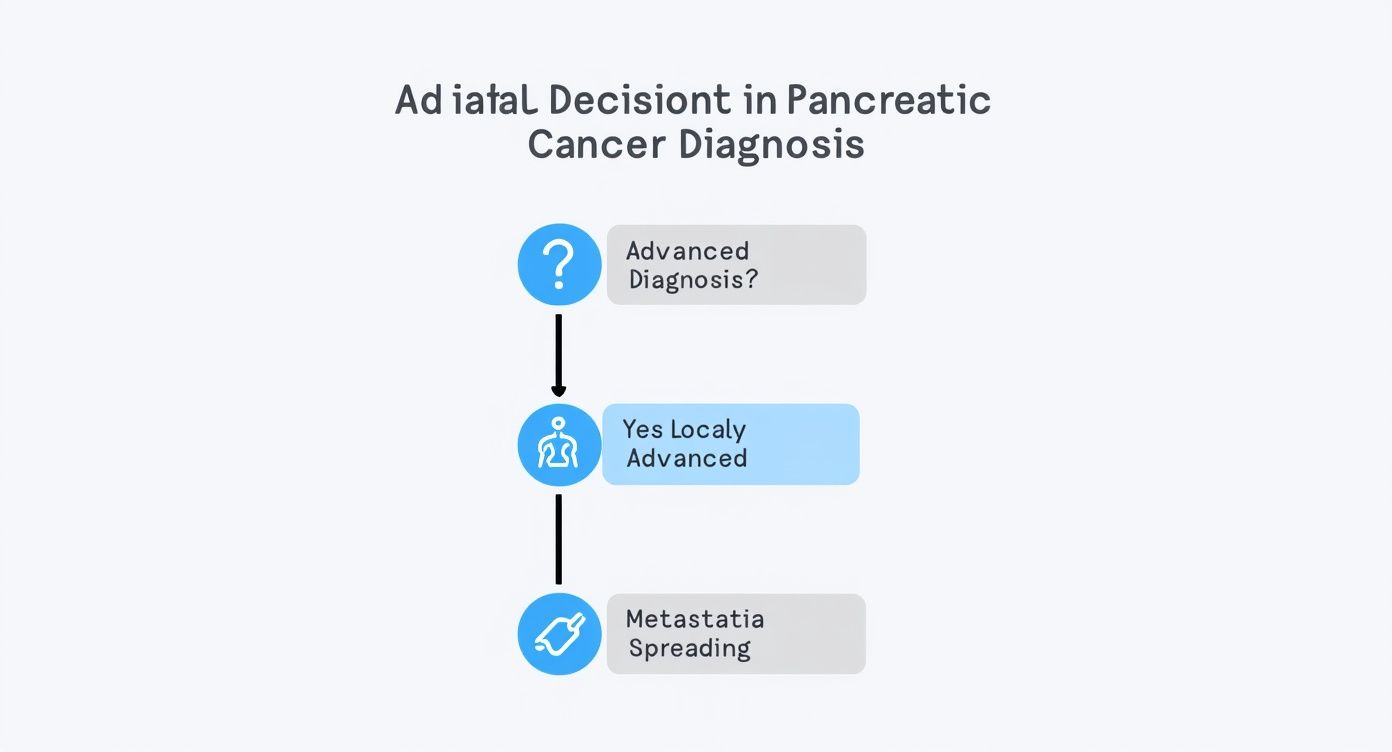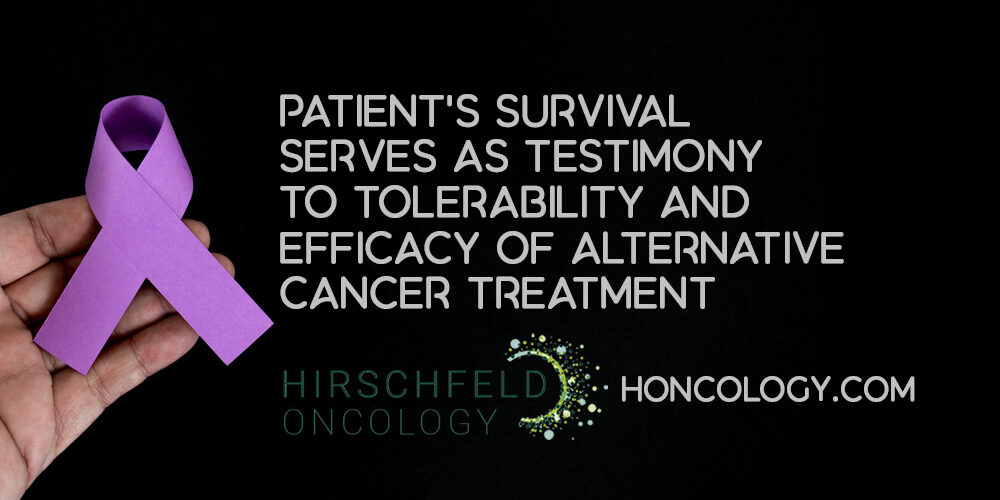Hearing the words "advanced pancreatic cancer" can feel like the world is tilting on its axis. It's a heavy diagnosis, and it’s completely normal to feel overwhelmed. But the first step in finding your footing is understanding what you're up against and what can be done.
At its core, treating advanced pancreatic cancer is about using systemic therapies—treatments that work throughout the whole body—to manage the disease, extend life, and most importantly, preserve your quality of life. Think of this guide as your first conversation, a way to start making sense of the diagnosis and the treatment paths that lie ahead.
Your Guide to Navigating Advanced Pancreatic Cancer
When doctors say pancreatic cancer is "advanced," they mean it’s no longer just a small, contained tumor in the pancreas. This is a critical distinction because it changes the entire game plan for treatment. There are two main scenarios here, and knowing which one applies to you is key.
Locally Advanced Cancer: Imagine the tumor has grown roots into major, non-removable blood vessels nearby. It hasn't traveled to distant organs yet, but it's tangled up in a critical area. The main goal here is often to see if we can shrink the tumor enough to make surgery a real possibility.
Metastatic Cancer (Stage IV): This is when cancer cells have broken away and traveled to other parts of the body, like the liver or lungs. At this point, surgery isn't the focus. Instead, treatment is about controlling the cancer wherever it is, managing symptoms, and helping you live as well as possible for as long as possible.
The Reality of the Diagnosis
Let’s be honest: pancreatic cancer is a tough opponent. A big reason for this is that it’s usually discovered late in the game. The statistics can be hard to look at, but they paint a clear picture of the challenge.
In the United States alone, an estimated 67,440 new cases are expected in 2025, with around 51,980 people likely to lose their lives to the disease. It’s currently the third leading cause of cancer-related death and is on track to become the second. The overall five-year relative survival rate has been stubbornly stuck at about 13%. You can see the latest figures in this report on pancreatic cancer statistics and survival rates on PanCAN.org.
Facing these numbers can be daunting, but they don’t tell your individual story. Medical science is continually providing new strategies and supportive care options that are improving outcomes beyond historical statistics.
Empowering Yourself with Knowledge
The whole point of this guide is to give you the information you need to be an active participant in your own care. When you understand the roadmap—from standard chemotherapy to personalized medicine—you can have much more productive conversations with your oncology team.
You’ll be able to ask better questions, understand the "why" behind their recommendations, and make choices that truly align with what matters most to you. This knowledge isn't just power; it's a tool for navigating the road ahead with more confidence and clarity. To get a better handle on the basics, you can explore our comprehensive guide on pancreatic cancer diagnosis and staging.
Understanding First-Line Chemotherapy Treatments
When we talk about treating advanced pancreatic cancer, chemotherapy is almost always the first line of defense. It’s a systemic approach, which means the drugs travel through your entire bloodstream to hunt down and attack cancer cells wherever they might be hiding. This is our foundational strategy to slow the cancer down, get symptoms under control, and ultimately, help you live longer.
For anyone facing this diagnosis, knowing why a certain chemotherapy is recommended is incredibly important. This isn't a one-size-fits-all decision. Your oncologist is carefully weighing your overall health, your physical fitness, and the unique details of your cancer to find the right starting point.
The Two Standard-of-Care Regimens
In recent years, major clinical trials have given us two powerful combination therapies that have become the go-to standards. They represented a significant step forward, extending median overall survival by about four months (FOLFIRINOX) and two months (gemcitabine/nab-paclitaxel) compared to the older single-drug approach.
Let's get to know these two main players:
FOLFIRINOX: This is a four-drug powerhouse (FOLinic acid, Fluorouracil, IRINotecan, and OXaliplatin). It's known for being the more aggressive option and, for the right patient, often the more effective one.
Gemcitabine plus Nab-Paclitaxel: A two-drug combination that is also very effective but is generally easier on the body. This makes it a solid choice for a wider group of people.
The infographic below helps visualize how the initial diagnosis—determining if the cancer is locally advanced or has spread (metastasized)—is the first step in mapping out this treatment journey.

As you can see, an "advanced" diagnosis isn't a single path. It branches out, and that distinction is critical for selecting the best systemic therapy.
Comparing First-Line Chemotherapy Regimens for Advanced Pancreatic Cancer
The choice between these two regimens isn't just about picking the "strongest" one; it's about finding the best fit for the individual. The table below breaks down the key differences to help illustrate how your oncologist approaches this decision.
Ultimately, the goal is to strike the perfect balance: hitting the cancer as hard as possible while protecting your quality of life.
Choosing The Right Path
So, how does the decision get made? It almost always comes down to your performance status—a clinical term for how strong you are and how well you can carry out daily activities.
FOLFIRINOX is typically reserved for people who are in excellent physical shape. Its power comes with a price: more intense side effects. Because of this, it's best suited for someone whose body is strong enough to handle the fight.
Gemcitabine plus nab-paclitaxel, on the other hand, is often the go-to for patients who are a bit older or are managing other health concerns. The side effects are still real but are often more manageable, making it a more practical choice for many.
Your oncologist’s recommendation is not just about attacking the cancer; it's about balancing effectiveness with your quality of life. The goal is to choose the most powerful weapon your body can safely handle.
Managing Side Effects Proactively
No matter the regimen, dealing with the side effects of chemotherapy is a huge part of the process. Your medical team has an entire toolkit to help you through it. This isn't an afterthought; proactive symptom control is built right into your treatment plan, with medications for nausea, strategies for diarrhea, and support for fatigue.
For those who are concerned about the harshness of these standard-dose regimens, it’s important to know other options are out there. For instance, you can learn more about low-dose chemotherapy from Hirschfeld Oncology, a strategy focused on delivering effective treatment with fewer debilitating side effects. Constant, open communication with your care team about how you're feeling is the key to staying ahead of side effects and living as well as possible during treatment.
How Personalized Medicine Is Changing Treatment
For decades, the standard way to fight cancer was a bit like using a sledgehammer to crack a nut—powerful, but not very precise. Today, we’re in a much smarter era of advanced pancreatic cancer treatment, one that zeroes in on the unique genetic fingerprint of each person's tumor. This is the world of personalized medicine, and it all starts with looking for specific clues, or biomarkers, inside the cancer cells themselves.
Think of it this way: your cancer has a unique lock on its door. Standard chemotherapy is like trying to knock the whole door down. Personalized medicine, on the other hand, is about finding the exact key that fits that specific lock, allowing for a much more targeted and often less damaging attack. This whole process kicks off with comprehensive genomic testing of your tumor tissue.

This testing essentially decodes the cancer's genetic instruction manual, searching for mutations or other alterations that we know how to exploit. The results can open up treatment paths that were unimaginable just a few years ago, moving us far beyond the one-size-fits-all chemotherapy model.
Targeting Specific Genetic Weaknesses
Once genomic testing finds a specific biomarker, we can often match it with a drug designed to target that exact vulnerability. This is a complete game-changer. Instead of a treatment that broadly attacks all fast-growing cells (including healthy ones), we can now hit the cancer precisely where it’s weakest.
In pancreatic cancer, two of the most important biomarkers we look for right now are BRCA mutations and a feature known as Microsatellite Instability-High (MSI-H).
BRCA Mutations: While often linked to breast and ovarian cancer, mutations in the BRCA1 and BRCA2 genes are found in about 5-7% of people with pancreatic cancer. These mutations disrupt a cell's ability to repair its own DNA damage.
MSI-High (MSI-H) Status: This biomarker tells us the cancer cells have a faulty DNA "spell-checker," which leads to an unusually high number of genetic mutations. It's rare in pancreatic cancer (around 1-2% of cases), but when we find it, it's a powerful sign that a specific type of therapy will work.
Discovering one of these biomarkers is like finding an Achilles' heel in the tumor. It gives us a clear and actionable target. To learn more about this strategy, you can read our in-depth guide on the role of targeted therapy in cancer care.
Matching the Drug to the Biomarker
The true power here comes from using specific drugs that can exploit these genetic flaws. These aren't chemotherapy drugs; they're precision tools built for a single, specific job.
“Personalized medicine is about treating the person, not just the disease. By understanding the unique biology of a tumor, we can select treatments that offer the greatest chance of benefit with the least amount of collateral damage.”
For patients whose tumors have a BRCA mutation, a class of drugs called PARP inhibitors has been incredibly effective. Because the BRCA mutation has already broken one of the cancer cell's DNA repair tools, the PARP inhibitor comes in and blocks its backup repair pathway. This one-two punch is catastrophic for the cancer cell, causing it to self-destruct while leaving most healthy cells alone.
For tumors identified as MSI-High, the breakthrough treatment is immunotherapy, specifically a type of drug called a checkpoint inhibitor. These drugs don't attack the cancer directly. Instead, they essentially "take the brakes off" your own immune system, allowing your body's T-cells to finally recognize the highly mutated cancer cells as a threat and attack them.
The Importance of Early Testing
This whole approach underscores why it's so critical to ask your oncologist about comprehensive genomic or biomarker testing, preferably right when you're diagnosed. Without this vital information, you might never know if you're a candidate for these powerful and often better-tolerated treatments.
The science is moving fast. Researchers have also identified rare NRG1 fusions in some pancreatic cancers, which has led to developing new drugs like zenocutuzumab to block the signals driving those tumors. In one clinical study, a remarkable 42% of pancreatic cancer patients with this specific fusion saw their tumors shrink. It's a perfect example of why detailed testing matters.
Knowing your tumor’s unique genetic profile is now a fundamental part of modern advanced pancreatic cancer treatment. It empowers you and your entire care team to make the most informed decisions possible, ensuring every therapeutic avenue is explored from day one.
Exploring New Frontiers in Pancreatic Cancer Care
Beyond the familiar pillars of chemotherapy and targeted therapy, researchers are constantly pushing the boundaries to find new ways to outsmart this incredibly tough disease. This forward momentum is what gives us new avenues of hope and more sophisticated tools for fighting advanced pancreatic cancer. The future of treatment is being shaped right now in clinical trials, where scientists are testing entirely new concepts for getting control of tumor growth.
One of the most interesting recent developments is a completely non-invasive approach called Tumor-Treating Fields (TTFields). This isn't a drug. It’s a wearable, portable device that creates low-intensity electrical fields designed to disrupt cancer cells.
Think of it this way: to grow and spread, cancer cells must divide rapidly, a process that requires a perfectly organized internal assembly line. The electrical fields generated by the TTFields device essentially jam that assembly line, throwing a wrench into the works and making it incredibly difficult for the cells to multiply. What’s remarkable is that this disruption is selective, having little to no effect on the healthy, non-dividing cells nearby.
A Breakthrough in Localized Treatment
The real excitement around TTFields comes from a major Phase III clinical trial called PANOVA-3. The study focused on patients with locally advanced pancreatic cancer—tumors that couldn't be removed with surgery. Researchers wanted to know if adding TTFields to standard chemotherapy could improve survival compared to chemo alone.
The results were a huge step forward.
The trial showed a clear and statistically significant improvement in overall survival. Patients who used the TTFields device alongside their chemotherapy lived longer and had longer pain-free survival, all without adding significant systemic toxicity to their bodies. This is the first time a trial has ever shown a survival benefit by adding a local therapy to a systemic one in this specific situation. You can read more about these promising advances in pancreatic cancer.
For a disease where progress has often been measured in small, incremental steps, finding a new approach that extends life without piling on harsh side effects is a major victory for patients and their families.
This success has opened the door for more research. If approved, TTFields could very well become a new standard of care for this group of patients.
Harnessing the Immune System and Beyond
While TTFields represent a novel physical approach, other researchers are focused on teaching the body's own immune system how to fight pancreatic cancer more effectively. This is the goal behind two other exciting frontiers: novel immunotherapies and cancer vaccines.
Novel Immunotherapies: We know that standard checkpoint inhibitors work wonders for the small percentage of MSI-High tumors, but they don’t do much for most pancreatic cancers. Scientists are now developing next-generation immunotherapies, like CAR-T cell therapies and bispecific antibodies, which are engineered to help the immune system finally recognize and attack pancreatic cancer cells that it would normally ignore.
Cancer Vaccines: Unlike the vaccines we get to prevent disease, these are therapeutic vaccines designed to train a patient's own immune system to hunt down and destroy existing cancer cells. Several are in development, often using pieces of the tumor’s own proteins (antigens) to provoke a highly personalized and targeted immune response.
These are the kinds of research areas that are truly changing the landscape of advanced pancreatic cancer treatment. Each new discovery, whether it’s a physical device like TTFields or a biological strategy like a vaccine, brings us closer to a future where more effective and gentler options are available for everyone facing this diagnosis.
The Importance of Supportive and Palliative Care

When you're navigating advanced pancreatic cancer treatment, the focus isn’t just on the cancer itself. It’s on you, the whole person. Supportive and palliative care is a critical part of your overall plan, helping you maintain your strength, comfort, and the best quality of life possible throughout your journey.
Let's clear up a common misconception right away: palliative care is not the same as hospice or end-of-life care. That's a myth. Think of it as a specialized field of medicine focused entirely on providing relief—from symptoms, from pain, and from the immense stress that comes with a serious illness.
It’s an extra layer of support that works in parallel with your cancer treatments, not in place of them. In fact, research shows that bringing in palliative care early, ideally right from the time of diagnosis, actually improves patient well-being and overall outcomes.
What Does Palliative Care Involve?
Your palliative care team is a group of specialists—doctors, nurses, dietitians, and more—who are experts in symptom management. Their job is to anticipate and ease the physical and emotional burdens that pancreatic cancer and its treatments can create.
They look at the big picture, addressing a whole range of issues to make sure you feel as good as you can, day in and day out. This holistic support makes a world of difference.
Key components often include:
- Advanced Pain Management: Using a mix of medications and other therapies to control pain caused by the tumor or treatment side effects.
- Nutritional Support: Tackling weight loss and digestive problems, which are particularly common with pancreatic cancer.
- Symptom Control: Actively managing things like nausea, fatigue, and anxiety to help you tolerate your primary treatments better.
- Emotional and Spiritual Support: Offering resources to help you and your family cope with the emotional weight of a cancer diagnosis.
Nutritional Support Is Especially Critical
For anyone with pancreatic cancer, just getting enough nutrition can be a major battle. The pancreas makes the enzymes we need to digest food. When it's not working right, it can cause serious digestive issues, poor nutrient absorption, and significant weight loss.
This is where a specific therapy called Pancreatic Enzyme Replacement Therapy (PERT) is essential. PERT involves taking prescription enzymes with every meal and snack to help your body break down food and absorb the nutrients it needs.
Working hand-in-hand with a registered dietitian, a palliative care team can dial in your exact PERT dosage and offer personalized dietary advice. This proactive approach helps you keep your weight up and your strength in reserve, which is absolutely vital for withstanding chemotherapy.
Empowering Yourself Through Supportive Care
Think of palliative care as a second team of experts in your corner, completely dedicated to your well-being and working in sync with your oncologist. They make sure symptom management is never an afterthought—it’s a central part of your advanced pancreatic cancer treatment from day one.
Don't ever hesitate to ask for a palliative care consultation. By making your comfort a top priority from the very beginning, you empower yourself to face treatment with more strength, more resilience, and a better quality of life. It’s a proactive step that helps you stay in control.
Finding Your Personalized Treatment Path
We've covered a lot of ground in this guide, from standard chemotherapy to the very latest targeted drugs for advanced pancreatic cancer. But having all this information is one thing; figuring out what it means for you is another entirely. The real challenge is turning knowledge into a practical treatment plan that fits your diagnosis, your body, and your life.
Your journey is yours alone, and your treatment plan should reflect that. This is where a true partnership with your oncology team is so crucial.
It All Starts With a Conversation
At Hirschfeld Oncology, everything begins with an in-depth consultation. We don't just glance at scans and lab results. We sit down with you to truly understand your entire medical story, what you hope to achieve with treatment, and what "quality of life" means to you personally.
Crafting a Strategy That Makes Sense for You
Our approach is simple: blend leading-edge science with genuine, compassionate care. We don't rely on a one-size-fits-all playbook. Instead, we use every detail available—from your tumor's specific genomic biomarkers to how you're feeling day-to-day—to design a regimen that's built just for you. That might mean starting with a standard-of-care therapy, exploring a clinical trial, or even developing a carefully managed low-dose strategy.
The goal is always the same: find the most effective path forward that aligns with your body and your personal priorities.
Think of your treatment plan not as a rigid set of rules, but as a living document. It should adapt to your needs and evolve as your situation changes and new options emerge. It’s a strategy built for you as a whole person, not just for the cancer.
We are dedicated to bringing the most promising treatments to our patients. This includes access to innovative clinical trials, which we strive to make available at local cancer centers close to home. Minimizing the burden of travel lets you focus on your health while staying close to your family and support system.
Taking the Next Step Forward
Feeling empowered in your cancer care starts with understanding your options. The next step is to have a real conversation about what these different therapies could mean for you and your specific situation.
We encourage you to schedule a consultation with our team. This one-on-one discussion is where the process truly begins. It's our chance to answer your questions, listen to your concerns, and start building a proactive, hopeful strategy together. Your personalized path forward starts with this conversation.
Frequently Asked Questions
When you or a loved one is diagnosed with advanced pancreatic cancer, the questions can feel overwhelming. We've gathered some of the most common ones we hear from patients and families to provide clear, straightforward answers and help you navigate the path ahead.
What’s the Difference Between Locally Advanced and Metastatic Cancer?
This is a crucial question, as the answer really shapes the entire treatment strategy. Think of it this way:
Locally advanced pancreatic cancer means the tumor has grown outside the pancreas itself, often tangling with major nearby blood vessels. However, it hasn't spread to distant parts of the body like the liver or lungs. In this situation, the goal is often to shrink the tumor enough to pull it away from those critical structures, sometimes making surgery a real possibility down the line.
Metastatic pancreatic cancer (Stage IV), on the other hand, means the cancer cells have already traveled through the bloodstream or lymph system and set up camp in distant organs. When this happens, surgery is no longer the focus. Instead, treatment shifts to systemic therapies—treatments that travel throughout the whole body—to control the cancer wherever it is, manage symptoms, and preserve your quality of life for as long as possible.
Should I Get a Second Opinion?
Yes. It’s not just a good idea; it’s a proactive and empowering step in your care. Dealing with a diagnosis as serious as advanced pancreatic cancer means you want to be absolutely certain you've explored every possible angle.
Getting a second opinion isn't about doubting your current doctor. In fact, most oncologists expect and encourage it. Here’s what it can do for you:
- Confirm the Diagnosis: It offers peace of mind that the initial findings are correct.
- Explore Different Approaches: Another expert might have a different perspective on treatment sequencing or recommend a novel combination of therapies.
- Open Doors to Clinical Trials: You could discover innovative trials or treatments that weren't on the table at your first center.
Ultimately, a second opinion helps ensure you feel confident and fully informed before committing to a treatment plan.
How Do I Find and Join a Clinical Trial?
Clinical trials are the engine driving progress in advanced pancreatic cancer treatment. They often provide access to the next generation of therapies years before they become standard.
The best place to start this conversation is with your oncologist. They understand the specific biology of your tumor and your overall health, making them the ideal person to help identify promising options.
You can also explore on your own. Reputable organizations like the Pancreatic Cancer Action Network (PanCAN) and the National Cancer Institute (NCI) have excellent, searchable databases of trials.
Keep in mind that specialized oncology consultancies can be a huge asset here. They often have deep connections in the research community and can pinpoint trials that are a perfect fit for your unique situation, sometimes even helping arrange for you to participate closer to home.
At Hirschfeld Oncology, our entire focus is on creating a personalized roadmap that reflects your specific diagnosis and personal goals. To see how we help patients explore every option, from innovative trials to custom-tailored regimens, we invite you to read more about our approach and patient stories on our blog: https://honcology.com/blog.





.png)


.png)
.png)




